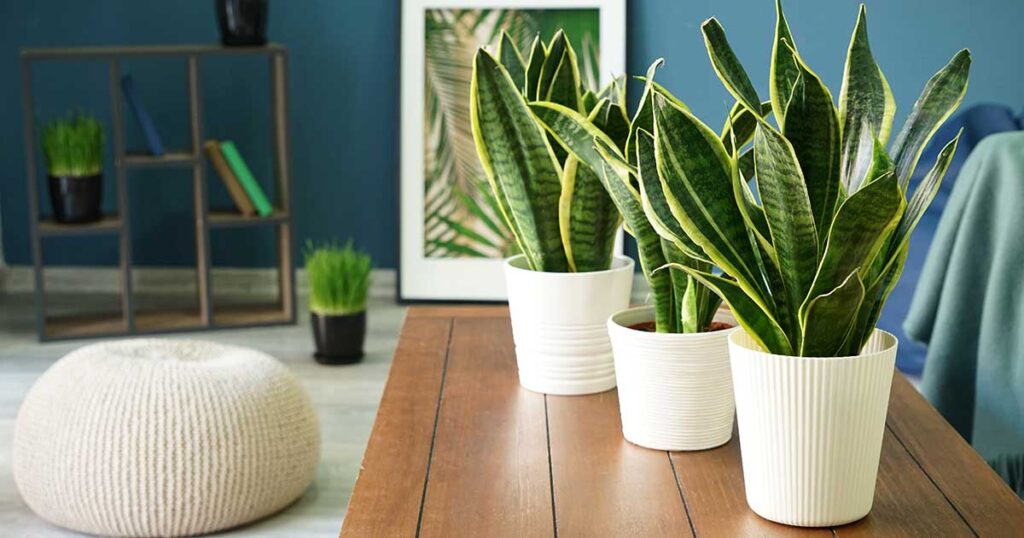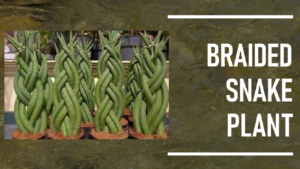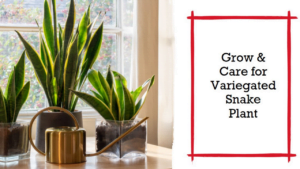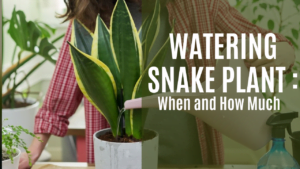Are you looking for a perfect pot for your beloved snake plant?
If yes, then you have come to the right place. We are here to help and save you from the time it takes you from reading the endless reviews and the stress to choose the right one!
Due to its ease of cultivation, the snake plant is one of the most common indoor plants. It is very important to choose the pot carefully for snake plants to ensure proper growth and development. We can understand that choosing a container for a plant can be more difficult than other purchases because there are a variety of pots available in the market.
That is why in this article, we will help you to choose the best pot that is available in the market with our detailed information about the types of pots available and which one can be suitable for you. So, let’s begin!
How can you choose a snake plant pot?
Choosing a container for a snake plant is not as easy as it seems, but it is not very challenging either. The key to growing a snake plant is to simply be aware of and attentive to the plant’s needs. When selecting the pot, the type of material used, the drainage system, the positioning, the depth, the width, etc, must all be taken into account. Therefore, we will now discuss the best ways for choosing the best pot for a snake plant!
1. Location requirement for the snake plants
Despite their preference for intense light, snake plants can flourish in locations with shade. The plant grows much more slowly when placed in a dark area compared to when it is in a bright area. The plant should be placed indoors 6 to 10 feet away from windows that face west, east, or south.
To provide the plant with the best care possible, you can purchase ceramic or terracotta pots with great air circulation capabilities. If the climate is excessively dry, use plastic pots to stop the plant from drying out too rapidly.

2. Size of the pot for the snake plants
The pot size is important since many plants grow in enormous pots, which inhibits the rate of growth. Greater space in larger pots may indicate that the plant’s roots have more room to work with when seeking water. You must be very careful when deciding on the size of the container your snake plant will grow in. Size is essential for a plant to grow more robustly and successfully.
You should purchase a pot that can house the plant throughout its development and growth stages because snake plants have a protracted life cycle. To get a new pot that is wider than an inch, measure the previously-used planter to establish the right size for the snake plant pot.
3. Temperature and humidity for the snake plants
The recommended indoor temperature for snake plants is between 16 and 24 degrees Celsius. The plant can withstand temperature variations but not extremely low temperatures. For the plant to thrive indoors, the humidity level must be between 40 and 50 percent. You must therefore purchase pots appropriate for such conditions based on the local temperature and humidity.
It is advisable to use terracotta or ceramic pots when the humidity in your room is high and the temperature is low. It will facilitate soil absorption of moisture from the environment. To prevent the soil of the snake plant from drying out too quickly, it is advisable to use plastic pots when the humidity is too low and the temperature is excessive.

4. Best pot material for the snake plants
When selecting the ideal pot material for your snake plants, you must consider the needs and wants of the plant as well as the advantages it gives. Since different materials have varied benefits depending on the characteristics of plants, it is crucial to know which materials would perform best for plants. Clay is the best kind of content material for succulents like snake plants.
Moreover, there is also the choice of ceramic and plastic pots. It is better to use plastic pots for fully grown or enormous snake plants to prevent cracking in the case that the roots extend out more than the pot can sustain. However, in the end, it depends on your plant’s needs and the environment it is placed in.
5. Proper water retention for the snake plants
The snake plant’s ability to retain water is essential to maintaining its life cycle over many generations. Consequently, you should choose a plant pot for your plant made of a material that can hold more water. There is a purpose for the material used in a pot’s construction, and it may affect plants more than you might imagine.
If you frequently overwater your snake plant, buying terracotta pots might be a smart idea because the clay absorbs moisture from the soil and dries out more quickly. Use plastic or glazed clay containers if you frequently neglect to water your plants because it preserves moisture in the soil, which is the cause of this.
6. Drainage system for the snake plants
A drainage system must work properly in a plant pot. It primarily has to do with helping the surplus water in the soil to drain. Therefore, good drainage reduces root rot in plants that arise from an excess of water. While snake plants don’t require much water, they do need it to continue growing and expanding.
Since snake plants thrive in soil that drains freely and is well-aerated, you should get a terracotta or ceramic container with at least one or two drainage holes for optimum water drainage. Thanks to a strong drainage system, the snake plant may gather the nutrients it needs without being drowned in water.
7. The growth rate of the snake plants
As was previously mentioned, snake plants can grow up to 4 feet tall in perfect conditions. Although it grows slowly, the snake plant is one of the succulents. As a result, you can count on the plant to gain a few inches each season. Additionally, snake plants will grow 2 to 4 leaves per season and hibernate during the winter.
Therefore, until you repot it, a medium-sized pot that can fit its roots will work, as opposed to choosing a container for a snake plant based on its rate of growth. If your giant snake plant is already mature and in a pot, you can repot it in one or two times its original size.

8. Snake plant variety and size of the plant
Depending on the variety, the snake plant can grow to a height of 1 to 4 feet and a width of 3 inches. However, the sort of plants you have will mostly decide the height and width. There are several sizes for both dwarf and large snake plants.
Examples of dwarf varieties include Trifasciata hahnii, Pavra, Pinguicula, Kirkii silver blue, Trifasciata twisted sister, etc. Ehrenbergii, trifasciata prain, Cylindrica, Bacularis, etc. are examples of large varieties. Therefore, depending on the type of plants you have, you can buy bigger or smaller pots that are perfect for your snake plant indoors or outdoors. Everything depends on what size you want for your plant.
What are the types of pots that you can use?

Many varieties of pots are available in the market which are difficult for you to choose from. But no need to worry, as we will list out all the types of pots and help you to choose the best one!
1. Terracotta or clay pots
Terracotta or clay pots are typically readily available, reasonably priced, and all-around commonplace. Due to their similarity in size and shape, finding complementary pots is simple. These pots can quickly drain water and keep the soil aerated since they are porous.
Because of its qualities, terracotta is the best material for snake plants. They feature beautiful patterns and look great in their muted color. There are certain disadvantages to using clay pots as well. When dropped, they are heavier and more brittle. Low temperatures during the winter may cause them to break.
2. Ceramic pots
Because of their gorgeous appearance, ceramic or glazed pots are used to cultivate the majority of indoor plants. These pots are sturdy, great for small plants, and offered in a variety of shapes and sizes. If plants are top-heavy, they weigh enough to prevent them from tumbling over.
Ceramic material has the drawback of being less porous than terracotta. You must therefore keep an eye on the soil’s moisture level. Large ceramic pots can be quite heavy and difficult to move. Additionally, they usually cost more than other materials. Also, it depends on your plant’s development and its comfort in the surroundings.
3. Plastic pots
Plastic pots are cheap, colorful, and lightweight. They are readily available, easy to reuse, and frequently offered. Moreover, plastic pots often come in a wide range of shapes, sizes, and styles. Since plastic is completely impermeable, no water can travel through it.
This might not be the best setting for snake plants since water cannot evaporate from the edges as it can in terracotta pots. This is why drainage holes are a need for plastic pots. Otherwise, the snake plant’s roots would start to rot very fast. The proper drainage system is essential to avoid any damage to the plant. Plastic pots frequently deteriorate and crack in the sun.
4. Wooden pots
The majority of large planters and individual pots are made of wood. Making wooden planters and pots from leftover wood is simple, portable, and water-tight. They have an authentic, rural vibe. You have to simply ensure that they are constructed from rot-resistant woods, such as cedar, mulberry, redwood, etc.
Pick high-quality containers because they may slightly compress or expand. To guard against rot, splintering, and fading, they are typically coated with a non-toxic clear varnish or toner.
5. Concrete pots
A concrete pot’s unusual appearance might go well with your decor. The earth is kept at a comfortable temperature because of concrete’s excellent insulation properties. Both large and tiny indoor and outdoor plants can be grown with them. Concrete outdoor pots can withstand weather fluctuations.
Even in the coldest winters or the hottest summers, they won’t crack. You might have expected that concrete pots would be somewhat hefty. Because of this, it is difficult to use them indoors for larger plants. Different types of concrete have varying degrees of porosity.
6. Metal pots:
Generally metal pots are made from either steel or aluminum and you can get them in a vast range of forms, structures, and shades. These pots with a combination of their shape and function, making them a favorable option for commercial backdrops, like cafes, resorts, restaurants, and workplaces.
Metal pots are sturdy and they don’t give themselves in scorching heat, get rusty under torrential rains, or grow in size and break when temperatures fluctuate. Both aluminum and steel pots are extremely hard-wearing, gladly resisting severe climate conditions without fear. A perfect kind pot for the hardiest houseplant ever known. Metal, mainly aluminum, is also very shapeable, making it effortless to shape into your desired mold. Plus, it can be powder painted in a vast range of different colors.
One main drawback to choosing metal as your pot material of choice is that these pots can get extremely hot when left out under the midday sun, scorching your snake plants, drying out the soil, and provoking the possibility of root damage. The good news, there is an easy way to get around this problem. Just try placing your metal planters in dark areas, such as underneath leafy, lush trees or on a porch.
Note:
Metal containers, particularly large ones, may be rather heavy and hard to move around.
7. Fiberglass pots:
The most suitable material for outdoor snake plants and plant pots on demand is undeniably fiberglass. Fiberglass containers are earning popularity and getting favored by gardeners cause of their versatility, and sustainability for experienced green gardens. Fiberglass pots are quite firm and adjustable. They can be employed both indoors and outdoors and are immune to all sorts of weather fluctuations. Minor scratches, wear, and rips can also be easily wiped out or painted over.
The planter is UV-resistant, temperature-resistant, and shatter-proof. You don’t have to stress about paint fading thanks to the coatings of the protective layers. Wiping with a gentle soap solution on a routine basis allows it to maintain its brand-new glazes.
Fiberglass pots are not that expensive compared to heavier materials like timber and metal, but they are way more expensive than plastic and clay pots. Also, Some pot makers take shortcuts while constructing this material. This is achieved by incorporating additional resin and fillers that have no structural function but just add extra weight.
FAQ’s
Q1. Do Snake Plants Need Deep Pots?
Ans. An overly deep pot can prevent drainage and let water sit for an extended period. While still being confined in the pot, the plant needs room to expand. The snake plant’s rhizomes or roots spread outward rather than descending into the ground. Your plant’s roots may come in contact with the pot’s base. In a shallow pot that fits snugly, your plant will thrive.
Q2. Do Snake Plants Like to be Crowded?
Ans. Snake plants like being so close together. The root system functions best when it works as a large team so that the plant may get all the nutrients it needs. The snake plant is one of the uncommon plants that like to be crowded and slightly root-bound. It is acceptable for the roots to adopt the shape of the pot that they are in as long as they do not protrude from the drainage holes in the pot.
Q3. Should I put rocks in the bottom of my snake plant?
Ans. Yes, you should add pebbles to the bottom of the pot before adding the soil and snake plant. Concerning a water tray, don’t worry. The soil can release more water and prevent root damage by using the rocks as a water tray. This should be alright because the snake plant is so incredibly resilient.
Q4. Do Snake Plants Like To Be In Small Pots?
Ans. To allow the plant to grow appropriately without taking up too much space, snake plants require a pot that is 1/3 larger than the roots. A pot that is too big could allow extra water to accumulate. The plant may experience shock if it is moved too soon in its pot size. The maximum pot size you should use if your plant is in a four-inch container is six inches.
Q5. When should I repot my snake plant?
Ans. Late winter or the beginning of spring are the ideal times to repot your indoor plant. Because your plant is dormant for the winter and it’s just before the busy growing season, this time works well.
Q6. What is the best potting for snake plants?
The best soil mix for snake plants is quick-draining and slightly acidic, with a pH between 5.5 and 7.5 potting soil. A soil mix that has peat moss, perlite, and vermicompost is perfect for the plant. The soil should also be loose and light, making it good for drainage and oxygenation of the plant’s roots.
Q7. Which pots are best for snake plants according to Vastu Sastra?
According to Vastu Shastra, for positioning a small clay pot, the north and east sides of the house should be picked. Also, by positioning a big pot of clay on the southwest side of the house, you will never confront health issues. This keeps your health in better condition. Mainly you will not meet any concerns related to stomach. Your connection with your mother remains good. You get complete approval from your mother in your career.
Conclusion
Snake plants are beloved houseplants for a reason. They require pots that are proportionate to the size of the actual plant, not too big, and they prefer being slightly crowded; if repotting, choose a pot that’s only a little bigger. Snake plants are easy to care for, requiring infrequent watering and thriving in lower and indirect light settings.
Pretty much anyone can care for these lovely plants. The pot you choose for the snake plant should be according to its need and the surrounding it is placed in.
We hope the above-given information was helpful to you and cleared all your doubts regarding the pots of the snake plant. If you like this article, please comment down below, and don’t forget to share this article with your friends and family!







